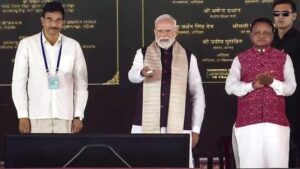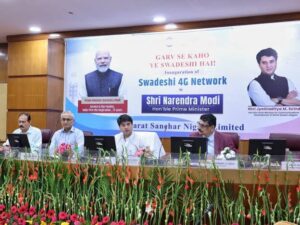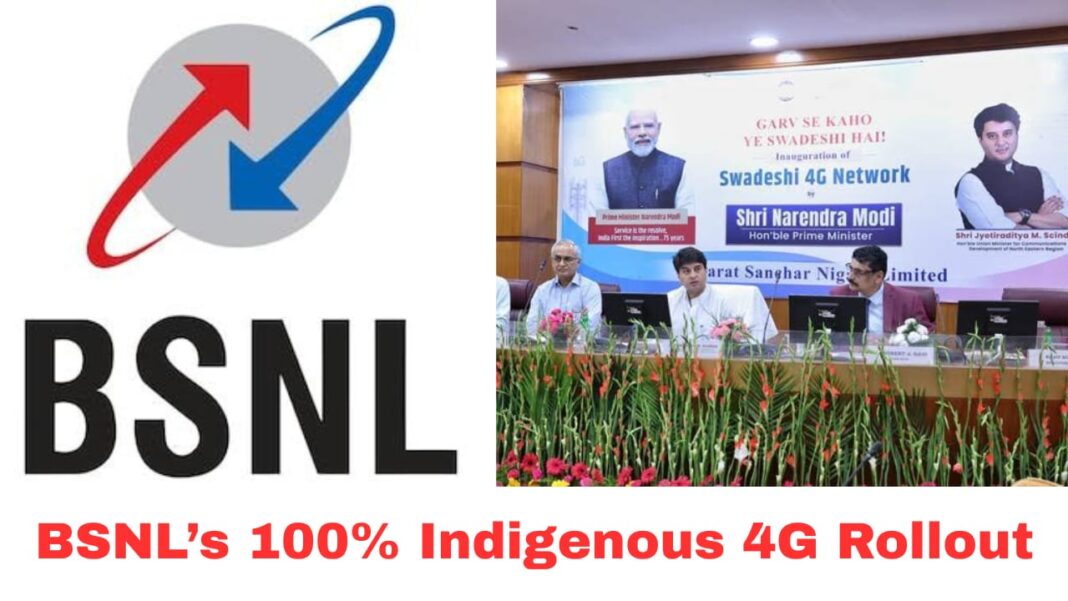Digital News Guru National Desk:
BSNL Rolls Out Fully Indigenous 4G Network: A Milestone in India’s Telecom Self-Reliance
In a landmark development for India’s digital infrastructure, Bharat Sanchar Nigam Limited (BSNL) has officially launched a 100 percent indigenous 4G network, marking a bold step toward self-reliance in telecom technology. The inauguration, presided over by Prime Minister Narendra Modi, signals the culmination of years of research, development and deployment in collaboration with Indian public and private technology firms.
A Glimpse into the Launch
On September 27, 2025, Prime Minister Modi inaugurated BSNL’s “Swadeshi 4G” network from Jharsuguda, Odisha, unveiling approximately 97,500 mobile towers to enable pan-India coverage. These towers integrate India’s own telecom stack, designed to be cloud-based, software-driven, and seamlessly upgradable to 5G.

This development places India in the league of nations capable of producing and deploying a domestic telecom stack. According to the Communications Ministry, only a handful of countries — such as China, South Korea, Sweden, and Finland — have such capabilities.
At the launch, Union Communications Minister Jyotiraditya M. Scindia emphasized that these 4G towers and the technology stack represent a “historic step” toward a Viksit Bharat and will ensure that “no part of India will be left untouched.” The project is estimated to cost approximately Rs 37,000 crore.
The Technology Behind It
What makes this rollout particularly significant is that the entire 4G infrastructure is homegrown:
- Core network: Developed by C-DoT (Centre for Development of Telematics)
- Radio Access Network (RAN): Supplied by Tejas Networks
- System integration: Handled by TCS
Together, this consortium delivered a stack that is fully upgradable to 5G without needing wholesale hardware replacement.
The network is being rolled out with a “4G saturation” approach under the Digital Bharat Nidhi (DBN) scheme. Under this, 14,180 towers are funded directly under DBN, with additional support from private telecom companies (Reliance Jio, Bharti Airtel) in underserved areas. It aims to reach some 26,700 previously unconnected villages, especially in remote, border, and left‐wing extremism affected regions, thereby bringing over 2 million new subscribers online.
In states like Andhra Pradesh, nearly 5,985 towers are being commissioned, including 1,232 DBN-funded sites to cover ~2,641 remote villages. In Kerala, 318 new sites have been activated under the plan, aiming to expand 4G service into tribal and hard-to-reach regions; the Kerala Circle also plans to phase out 3G as 4G coverage expands.
In the northeast, for example Arunachal Pradesh, Nagaland, and Manipur, 1,969 sites have been planned for 4G deployment under DBN, covering over 1,700 villages.
Importantly, many of the new tower sites are solar-powered, aligning with a push for greener infrastructure.
Implications: What This Means for India
Bridging the Digital Divide
One of the most immediate impacts will be in rural and remote regions that were previously underserved or had only 2G/3G coverage. The saturation model means even far-flung border areas can become part of the digital mainstream.

This can accelerate access to online education, telemedicine, digital governance services, agriculture advisory apps, e-commerce, and more — leveling the playing field across India. As Minister Scindia put it, farmers in Punjab will get real-time mandi updates, students in Bihar will access quality online learning, and border security forces can stay reliably connected.
Strategic & Technological Independence
By deploying an indigenous 4G stack, India reduces its dependence on foreign telecom equipment, lowering risks related to supply chains, geopolitical pressures, and security vulnerabilities.
It also positions India among a select group of nations capable of designing and manufacturing their own telecom systems — a significant boost to “Make in India” ambitions.
Moreover, because the network is software-driven and future-ready for 5G, the upgrade path is smoother and less capital-intensive than typical green-field transitions.
Competitive Challenges Ahead
While this is a breakthrough, BSNL faces stiff competition from private telecom players (Reliance Jio, Airtel, etc.) that have already invested heavily in 5G infrastructure in many parts of the country.
The success of the rollout will depend on quality of service (QoS), uptime, coverage consistency, cost competitiveness, and operational efficiency. Ensuring smooth transition and minimizing outages during the upgrade will be critical.
Another challenge is monetization and subscriber traction — even with expanded coverage, attracting users to switch or stay loyal to BSNL will require competitive data plans, marketing, and service reliability.
Toward 5G and Beyond
BSNL’s 4G deployment is designed with a foresight: upgrades to 5G can happen primarily through software enhancements, minimizing hardware overhauls. Indeed, the government has asserted that no foreign technology will be used in future 5G deployments for BSNL.
According to reports, BSNL aims to launch 5G services in Delhi and Mumbai by December 2025, subject to stabilization of the 4G network.

Looking Ahead: Risks, Hopes, and Milestones
This is a bold, ambitious undertaking — not without risks. Potential bottlenecks include delays in tower installations, regulatory approvals (especially in sensitive areas or protected forests), power and backhaul infrastructure, and coordination with state governments.
However, the payoff could be immense: if executed well, India may leap ahead in digital inclusion, rural connectivity, and technological autonomy. BSNL’s success could set a template not just for telecom, but for how India approaches large-scale infrastructure in the digital era.
In the coming months, key indicators to watch will include:
- Coverage rollout pace in hard-to-reach geographies
- Quality metrics: latency, download/upload speeds, network uptime
- User uptake and migration from older 2G/3G services
- Financial viability: ARPU (average revenue per user), cost recovery
- The first public 5G rollouts by BSNL leveraging this stack
In sum, BSNL’s indigenous 4G rollout is more than a technological upgrade — it is a statement of intent. It says that India is not just a consumer of global telecom gear, but a creator of it. If successful, this project could accelerate India’s journey toward a fully digital, sovereign, and inclusive future.
You May Also Read: Durga Puja 2025: Top Theme-Based Pandals Across India








